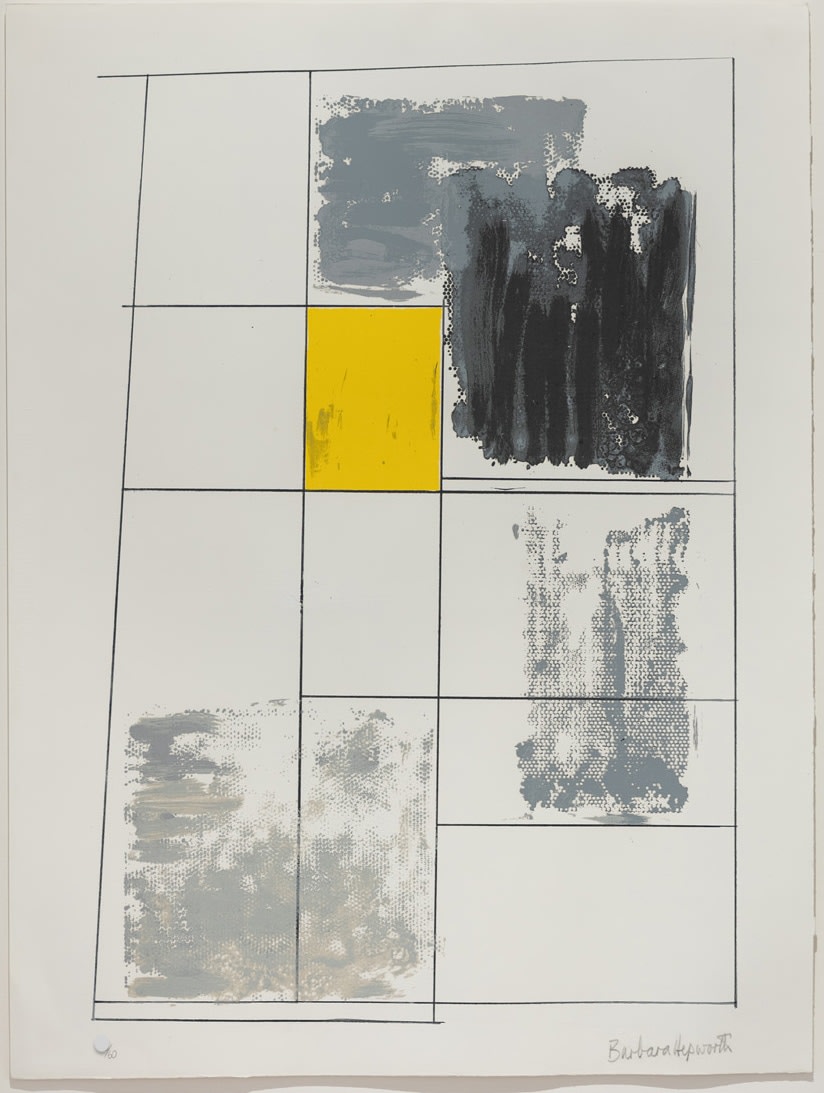Barbara Hepworth British, 1903-1975
Assembly of Square Forms, 1970
Screenprint on TH Saunders wove paper
Signed by the artist in pencil, lower right on recto
Signed by the artist in pencil, lower right on recto
78.1 × 58.1 cm
© The Estate of Barbara Hepworth
'Assembly of Square Forms' (1970) reflects Hepworth's longstanding exploration of geometric forms. It demonstrates her mastery of spatial relationships and ability to translate three-dimensional concepts into print format. The work...
'Assembly of Square Forms' (1970) reflects Hepworth's longstanding exploration of geometric forms. It demonstrates her mastery of spatial relationships and ability to translate three-dimensional concepts into print format. The work shows how forms can interact and create tension through arrangement and positioning.
Created during a pivotal period in British modernism, 'Assembly of Square Forms' emerged when Hepworth was already established as one of Britain's most significant sculptors. By 1970, she had completed major public commissions, including works for the United Nations. The print medium allowed her to explore familiar themes in new ways, demonstrating her artistic versatility late in her career.
The work represents a natural progression from Hepworth's sculptural practice, where she had long been interested in the relationship between forms and space. Her earlier breakthrough with pierced forms in sculpture translated into her printmaking through her exploration of positive and negative space. The geometric abstraction in 'Assembly of Square Forms' reflects her continued interest in formal purity, which she had developed through her associations with European modernists like Mondrian and Brancusi.
Hepworth's position as a leading figure in post-war British art cannot be overstated. Along with Henry Moore, she helped establish Britain as a centre for modern sculpture. Her work bridged the gap between abstract modernism and organic form, influencing generations of artists that followed. The creation of the 'Assembly of Square Forms' coincided with a period when British art was gaining international recognition, mainly through the efforts of the British Council and critics like Herbert Read.
This print, created near the end of her career, encapsulates many of the formal concerns that preoccupied Hepworth throughout her artistic journey. It demonstrates her enduring interest in geometric abstraction while showcasing her ability to adapt her sculptural vocabulary to different media. The work is a testament to her versatility and continuing innovation, even in her later years, and represents an essential aspect of her contribution to 20th-century British modernism.
Created during a pivotal period in British modernism, 'Assembly of Square Forms' emerged when Hepworth was already established as one of Britain's most significant sculptors. By 1970, she had completed major public commissions, including works for the United Nations. The print medium allowed her to explore familiar themes in new ways, demonstrating her artistic versatility late in her career.
The work represents a natural progression from Hepworth's sculptural practice, where she had long been interested in the relationship between forms and space. Her earlier breakthrough with pierced forms in sculpture translated into her printmaking through her exploration of positive and negative space. The geometric abstraction in 'Assembly of Square Forms' reflects her continued interest in formal purity, which she had developed through her associations with European modernists like Mondrian and Brancusi.
Hepworth's position as a leading figure in post-war British art cannot be overstated. Along with Henry Moore, she helped establish Britain as a centre for modern sculpture. Her work bridged the gap between abstract modernism and organic form, influencing generations of artists that followed. The creation of the 'Assembly of Square Forms' coincided with a period when British art was gaining international recognition, mainly through the efforts of the British Council and critics like Herbert Read.
This print, created near the end of her career, encapsulates many of the formal concerns that preoccupied Hepworth throughout her artistic journey. It demonstrates her enduring interest in geometric abstraction while showcasing her ability to adapt her sculptural vocabulary to different media. The work is a testament to her versatility and continuing innovation, even in her later years, and represents an essential aspect of her contribution to 20th-century British modernism.



